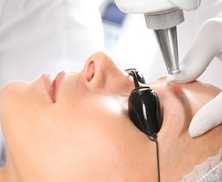When skin is damaged or wounded, a natural healing process begins to attempt to repair the wound. The collagen that is used to replace the damaged skin is the same protein used in the production of new skin, and yet scarring produces fibrous tissue that can be different in appearance to the surrounding skin.
Scars do not always form in the same way. When the body produces too much collagen, the skin will develop a raised appearance, and is known as a hypertrophic scar. If the tissue surrounding the wound is also destroyed, the resultant scar can have a depressed appearance and is known as an atrophic scar. This type of scarring is generally associated with acne or chicken pox.
Some scars improve in appearance over a period of time. The original pigmentation can fade, although the raised or depressed appearance is unlikely to show significant improvement if left untreated.
The scar treatment that provides the most effective results tends to be a combination of microdermabrasion, laser therapy and ultrasound treatment. The microdermabrasion gently and safely removes the superficial layers of the skin, revealing newer, smoother skin underneath.
The laser treatment stimulates the production of new collagen and healthy skin cells. The result is an improvement both in the appearance and feel of the damaged skin.































